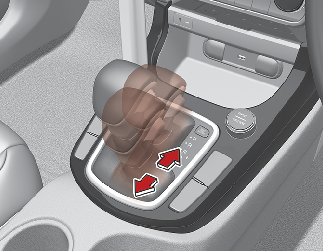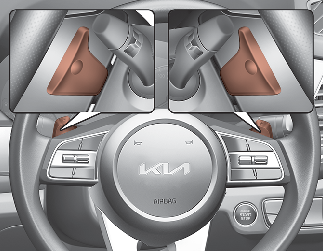Automatic transmission operation
The automatic transmission has 6 forward speeds and one reverse speed. The individual speeds are selected automatically, depending on the position of the shift lever.

The first few shifts on a new vehicle, if the battery has been disconnected, may be somewhat abrupt. This is a normal condition, and the shifting sequence will adjust after shifts are cycled a few times by the TCM (Transmission Control Module) or PCM (Powertrain Control Module).
For smooth operation, depress the brake pedal when shifting from N (Neutral) to a forward or reverse gear.

Automatic transmission
-
Always check the surrounding areas near your vehicle for people, especially children, before shifting a vehicle into D (Drive) or R (Reverse).
-
Before leaving the driver's seat, always make sure the shift lever is in the P (Park) position; then set the parking brake fully and shut the engine off. Unexpected and sudden vehicle movement can occur if these precautions are not followed in the order identified.
-
Do not use the engine brake (shifting from a high gear to lower gear) rapidly on slippery roads.
The vehicle may slip causing an accident.

-
To avoid damage to your transmission, do not accelerate the engine in R (Reverse) or any forward gear position with the brakes on.
-
When stopped on an incline, do not hold the vehicle stationary with engine power. Use the service brake or the parking brake.
-
Do not shift from N (Neutral) or P (Park) into D (Drive), or R (Reverse) when the engine is above idle speed.
Transmission ranges
The indicator in the instrument cluster displays the shift lever position when the ignition switch is in the ON position.
P (Park)
Always come to a complete stop before shifting into P (Park). This position locks the transmission and prevents the front wheels from rotating.

-
Shifting into P (Park) whilst the vehicle is in motion will cause the drive wheels to lock which will cause you to lose control of the vehicle.
-
Do not use the P (Park) position in place of the parking brake. Always make sure the shift lever is latched in the P (Park) position and set the parking brake fully.
-
Never leave a child unattended in a vehicle.

The transmission may be damaged if you shift into P (Park) whilst the vehicle is in motion.
R (Reverse)
Use this position to drive the vehicle backward.

Always come to a complete stop before shifting into or out of R (Reverse); you may damage the transmission if you shift into R whilst the vehicle is in motion, except as explained in More Details.
N (Neutral)
The wheels and transmission are not engaged. The vehicle will roll freely even on the slightest incline unless the parking brake or service brakes are applied.

Do not drive with the shift lever in N (Neutral).
The engine brake will not work and lead to an accident.
Parking in N (Neutral) gear
Follow below steps when parking and you want the vehicle to move when pushed.
-
For smart key equipped vehicles, the ignition switch can be moved to "OFF" only when the shift lever is in "P".

-
With the exception of parking in neutral gear, always park the vehicle in "P" (Park) for safety and engage the parking brake.
-
Before parking in "N" (Neutral) gear, first make sure the parking ground is level and flat. Do not park in "N" gear on any slopes or gradients.
If parked and left in "N", the vehicle may move and cause serious damage and injury.
This is the normal forward driving position. The transmission will automatically shift through a 6-gear sequence, providing the best fuel economy and power.
For extra power when passing another vehicle or climbing grades, depress the accelerator fully, at which time the transmission will automatically downshift to the next lower gear.

Always come to a complete stop before shifting into D (Drive).

Whether the vehicle is stationary or in motion, sports mode is selected by pushing the shift lever from the D (Drive) position into the manual gate. To return to D (Drive) range operation, push the shift lever back into the main gate.
In sports mode, moving the shift lever backwards and forwards will allow you to make gearshifts rapidly. In contrast to a manual transmission, the sports mode allows gearshifts with the accelerator pedal depressed.
-
Up (+): Push the lever forward once to shift up one gear.
-
Down (-): Pull the lever backwards once to shift down one gear.

-
In sports mode, the driver must execute upshifts in accordance with road conditions, taking care to keep the engine speed below the red zone.
-
In sports mode, only the 6 forward gears can be selected. To reverse or park the vehicle, move the shift lever to the R (Reverse) or P (Park) position as required.
-
In sports mode, downshifts are made automatically when the vehicle slows down. When the vehicle stops, 1st gear is automatically selected.
-
In sports mode, when the engine rpm approaches the red zone shift points are varied to upshift automatically.
-
To maintain the required levels of vehicle performance and safety, the system may not execute certain gearshifts when the shift lever is operated.
-
When driving on a slippery road, push the shift lever forward into the +(up) position. This causes the transmission to shift into the 2nd gear which is better for smooth driving on a slippery road. Push the shift lever to the -(down) side to shift back to the 1st gear.
Paddle shifter (if equipped)
The paddle shift function is available when the shift lever is in the D (Drive) position or the manual mode.

With the shift lever in the D position
The paddle shift function will operate when the vehicle speed is more than 10 km/h.
Pull the [+] or [-] paddle shifter once to shift up or down one gear and the system changes from automatic mode to manual mode.
When the vehicle speed is lower than 9 km/h, if you gently depress the accelerator pedal for more than 6 seconds or if you shift the shift lever from D (Drive) to manual mode and shift it from manual mode to D (Drive) again, the system changes, again, or pull the [+] paddle shifter for more than 1 second, the system changes from manual mode to automatic mode.
With the shift lever in the manual mode
Pull the [+] or [-] paddle shifter once to shift up or down one gear.

If you pull the [+] and [-] paddle shifters at the same time, you cannot shift the gear.